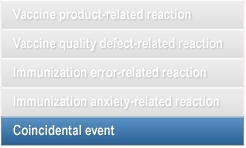Coincidental events

Coincidental events occur after a vaccination has been given but are not caused by the vaccine or its administration.
Vaccinations are normally scheduled in infancy and early childhood, when illnesses are common and congenital or early neurological conditions become apparent. Coincidental events are inevitable when vaccinating children in these age groups, especially during a mass campaign. Applying the normal incidence of disease and death in these age groups along with the coverage and timing of immunizations allows estimation of the expected numbers of coincidental events after immunization.
Estimates from the WHO Regional Office for the Western Pacific are presented in the table.
For example, in Australia, each year there are likely to be 11 coincidental infant deaths the day after immunization.
Immediate investigation of a severe adverse event attributed to a vaccine, but not causally related to it, is critical in order to:
- respond to a community's concern about vaccine safety,
- maintain public confidence in immunization.
Calculating the expected rate of an adverse event may be helpful during its investigation. Knowing the background rate of this adverse event enables the investigator to compare expected and post-vaccination rates of the event. An increase or non-increase of the post-vaccination rate may give a clue on whether the event is actually caused by the vaccine. With the background mortality of the AEFI that coincidentally follow vaccination is key when responding to AEFI reports.26 Further information on this subject can be found in this course on the page Rates of adverse reactions.47
Expected coincidental deaths following DTP vaccination in selected countries26
| Country | Infant Mortality Rate per 1000 live births (IMR) | Number of births per year (N) | Number of infant death during year in | ||
|---|---|---|---|---|---|
| Month after immunization | Week after immunization | Day after immunization | |||
| = (IMRxN/12)×nv×ppv | = (IMR×N/52)×nv×ppv | = (IMR×N/365)×nv×ppv | |||
| Australia | 5 | 267,000 | 300 | 69 | 10 |
| Cambodia | 69 | 361,000 | 5,605 | 1,293 | 185 |
| China | 18 | 18,134,000 | 73,443 | 16,948 | 2,421 |
| Japan | 3 | 1,034,000 | 698 | 161 | 23 |
| Laos | 48 | 170,000 | 1,836 | 424 | 61 |
| New Zealand | 5 | 58,000 | 65 | 15 | 2 |
| Philippines | 26 | 2,236,000 | 13,081 | 3,019 | 431 |
Note: Assumes uniform distribution of deaths and children who are near to death will still be immunized.
nv = number of immunization doses: assumed here to be three dose schedule; 3.
ppv= proportion of population vaccinated: assumed here to be 90% for each dose; 0.9.
Additional information
To support the analysis of events, WHO is developing vaccine reaction rates information sheets. These include observed rates of vaccine reaction found in scientific literature. See the attached document for further information.
Question
Based on the data in the table, how many infant deaths would you expect to occur coincidentally (i.e. not linked to the vaccine) in China the day after immunization with DTP?
| A. | C. |
| B. | D. |
Answer A is correct.
- The number of expected infant deaths occurring the day after DTP immunization would total 2,421.
Key point
Data banks that can provide locally relevant background rates of disease incidence are essential to aid assessment of vaccine safety and to determine whether AEFIs are causally related or coincidental.

